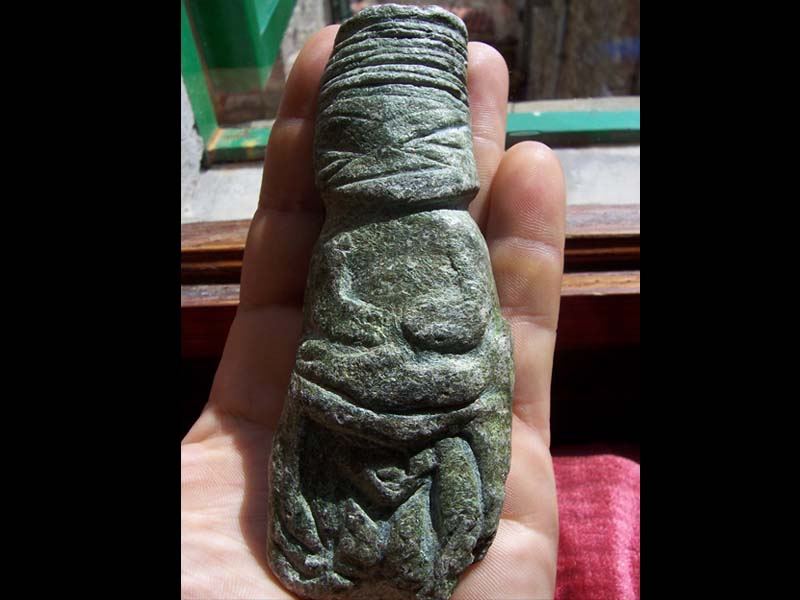It is a small statuette carved on a piece of green steatite, depicting a female figure with her head wrapped up in a hat, the eyes, nose and mouth visible, who seems to be holding a fetus on her lap and underneath the belly the symbol of the vulva in the shape of a "V"; the representation of the termination of the legs is also very particular, they resemble frog legs.
The find dates back to the Upper Paleolithic and was found in a suggestive place called "Devil's Den", caves where traces of archaic rituals were found, such as broken engraved and excised pottery, hearths with the remains of cereals and charred animals (marmots and ibex ), which allowed the site to be dated and led to the hypothesis that these caves were used as a prehistoric place of worship, with offerings and gifts to the "Mother Earth", like ex-votos.
An interesting hypothesis is that which traces the name of the site, "Devil's Den", to the rites that took place there; it would seem that originally these were the caves of Venus, which became, during the dark periods of Christianity, the caves of the devil to discredit the sacred places of the ancient cults; there are about 20 karst caves, developed along a narrow gorge called Fosso del Bagno Minerale, due to the presence of a mineral water source used since ancient times for thermal baths. Returning to the analysis of the statuette, there are few studies that allow us to establish the characteristics of the find; wishing to find analogies with other finds, one can refer to the statuettes on green stone depicting the goddess of childbirth in the shape of a frog, indicated by Marija Gimbutas with a regenerative symbolism deriving from their aquatic environment. “… Human life begins in the watery realm of a woman's womb, so by analogy the goddess was the source of all life, human, plant and animal. It reigned over all sources of water: lakes, rivers, springs, wells and rain clouds… The habitat of these beings constituted an analogy with the amniotic fluid, that uterine watery realm where regeneration takes place… Art neolithic fashioned thousands of female-frog hybrids. At many Neolithic sites, craftsmen carved small frog goddesses out of green or black stone and placed them in relief on vessels or temple walls. The presence of the divine vulva accentuates the regenerative force of these images… The image of the frog and the toad, together with the woman in the shape of a frog showing her vulva, spread over a wide period of time and not only in the European Neolithic and Anatolian, but also in the Middle East, in China and in the Americas… The conception of this image can even be traced back to the upper Paleolithic, since bones engraved with frog-women appear in the Magdalenian era… The dynamic peristence of the toad-goddess provides the explanation for a quite mysterious historical image: the “unchaste” Sheela na gig which appears on stone buildings in England, France, Ireland and Wales, seated, naked, with her frog legs spread wide, and with her hands on the vulva. These figures were carved on castles and churches between the twelfth and sixteenth centuries. They can usually be seen on the entrance arches or on the walls of churches. Both hands of the Sheela na gig point to her genital area or hold her lips apart. Some sculptures feature scary faces or even skeleton skulls. Sheela na gig is still highly revered, but her presence, of course, is shrouded in mystery. She can only be the descendant of the ancient frog-goddess, the great regenerator…” (M. Gimbutas – The living goddesses – Medusa 2005).

Historical notes
The statuette was found in the Nineteenth Century by Cesare De Sanctis, a doctor in land surveying sciences with a passion for archaeological reconnaissance. For about a century the statuette remained inside a chest until the lawyer Vittorio De Sanctis, keeper of the family finds, submitted the find to the Superintendent for Archaeological Heritage of Umbria, the archaeologist Maria Cristina De Angelis, who recognized the importance of the find.
CARD
LATEST PUBLISHED TEXTS
VISIT THE FACTSHEETS BY OBJECT

